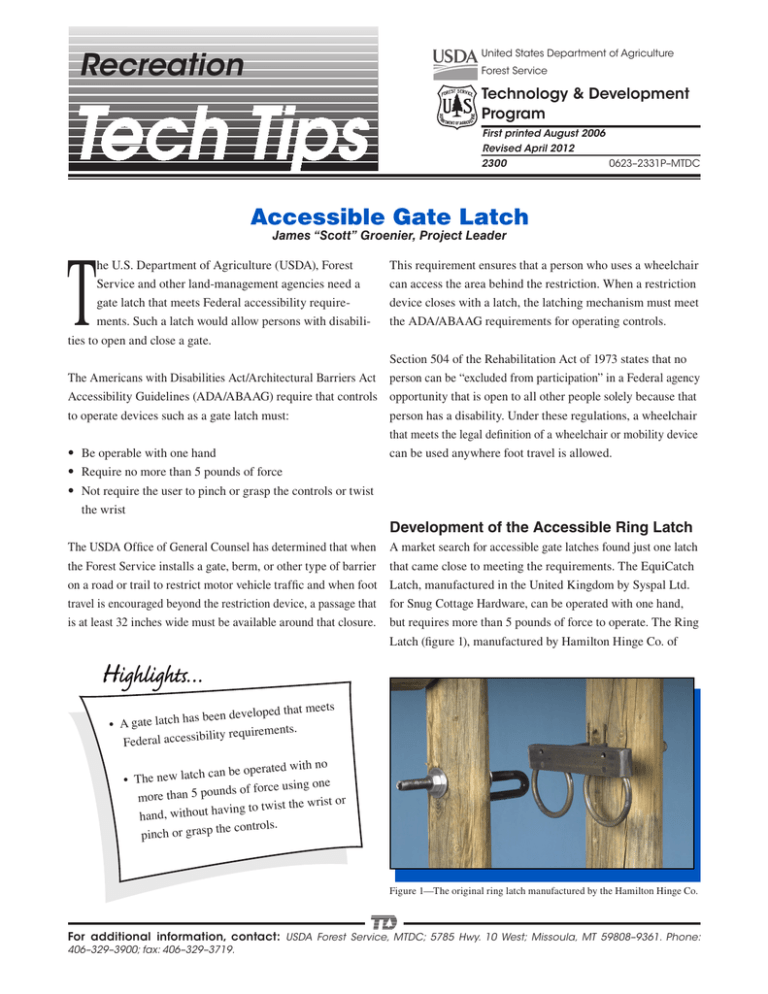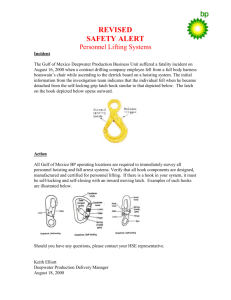T Recreation Accessible Gate Latch Technology & Development
advertisement

Recreation United States Department of Agriculture Forest Service Technology & Development Program First printed August 2006 Revised April 2012 2300 0623–2331P–MTDC Accessible Gate Latch James “Scott” Groenier, Project Leader T he U.S. Department of Agriculture (USDA), Forest Service and other land-management agencies need a gate latch that meets Federal accessibility requirements. Such a latch would allow persons with disabilities to open and close a gate. This requirement ensures that a person who uses a wheelchair can access the area behind the restriction. When a restriction device closes with a latch, the latching mechanism must meet the ADA/ABAAG requirements for operating controls. Section 504 of the Rehabilitation Act of 1973 states that no The Americans with Disabilities Act/Architectural Barriers Act person can be “excluded from participation” in a Federal agency Accessibility Guidelines (ADA/ABAAG) require that controls opportunity that is open to all other people solely because that to operate devices such as a gate latch must: person has a disability. Under these regulations, a wheelchair that meets the legal definition of a wheelchair or mobility device • Be operable with one hand can be used anywhere foot travel is allowed. • Require no more than 5 pounds of force • Not require the user to pinch or grasp the controls or twist the wrist Development of the Accessible Ring Latch The USDA Office of General Counsel has determined that when the Forest Service installs a gate, berm, or other type of barrier on a road or trail to restrict motor vehicle traffic and when foot travel is encouraged beyond the restriction device, a passage that is at least 32 inches wide must be available around that closure. A market search for accessible gate latches found just one latch that came close to meeting the requirements. The EquiCatch Latch, manufactured in the United Kingdom by Syspal Ltd. for Snug Cottage Hardware, can be operated with one hand, but requires more than 5 pounds of force to operate. The Ring Latch (figure 1), manufactured by Hamilton Hinge Co. of that meets been developed s ha h tc la te ga • A ts. ility requiremen Federal accessib with no can be operated • The new latch g one ds of force usin more than 5 poun wrist or ving to twist the hand, without ha e controls. pinch or grasp th Figure 1—The original ring latch manufactured by the Hamilton Hinge Co. For additional information, contact: USDA Forest Service, MTDC; 5785 Hwy. 10 West; Missoula, MT 59808–9361. Phone: 406–329–3900; fax: 406–329–3719. 1 Corvallis, MT (406–961–4086), required less than 5 pounds of force, but required two hands for operation. The latch still has minor problems. A second guard ring (gray) can be built into the design to further discourage horses (figure 3) from playing with the mechanism. The guard rings are stock MTDC contacted Loyd Beaver, the owner of Hamilton Hinge resistant, but not stock proof. Clever horses with lots of time Co., to discuss modifying the existing latch to make it acces- may open the latch eventually. Another common problem for sible. At the time, Beaver did not have a latch design that would all gates is normal wear and tear that causes the gates to fall meet the requirements for accessibility. He agreed to work out of alignment. Periodic gate maintenance is needed to keep with MTDC to see if one could be developed. A collaborative the gate working properly. effort produced the Accessible Ring Latch (figure 2) design. The parts of the latch illustrated here have been painted different colors to help show how the latch works. The rings that keep the gate closed are black. The guard ring that discourages horses from opening the gate is red. The lever that lifts the rings so the gate will open is green. The gate pin is yellow. Figure 3—An Accessible Ring Latch with guard rings (gray and red) on both sides of the lever to make it difficult for horses to open the latch. Operating the Accessible Ring Latch Figure 2—An Accessible Ring Latch with a guard ring (red) on one side. This new ring latch meets the ADA/ABAAG Accessibility Guidelines requirements. It can be opened with less than 5 pounds of force and the gate can be pushed open with a closed hand or an elbow, without twisting the wrist or pinching or grasping the rings or the gate. The latch must be mounted between 15 and 48 inches above the ground and the reach must not be obstructed. 2 The Accessible Ring Latch is easy to use. One caution: Do not push on the gate before pressing down on the lever or the ring will bind. 1. Press down on the lever with your hand or elbow (figure 4). 2. Continue to press down until the ring on the far side lifts to its highest position (figure 5). 3. Rotate your arm or hand to put slight pressure on the gate (figure 6). 4. Release the lever (figure 7). 5. The gate is open (figure 8). Figure 4—One hand presses down on the lever (green) of the accessible latch. Figure 5—When the lever (green) is pressed down, one ring (black) is lifted out of the way. Figure 6—Pressure is applied to the gate and lever (green) at the same time, opening the gate. Figure 7—When the lever (green) is released, the gate begins to open. Figure 8—The gate is opening to allow passage. 3 Another Gate Latch Opening the latch required more than the 5 pounds of force allowed by Federal accessibility requirements, even when the The EquiCatch Latch (figure 9), manufactured in the United Kingdom, was “designed to fulfill the needs of the DDA,” the latch was lifted from the center. When the latch was lifted United Kingdom’s Disability Discrimination Act (1995). The from one edge with a closed fist, it required even more force to requirements of that act differ from the accessibility require- open. ments in the United States. More information about the EquiCatch can be found at http:// www.snugcottageimports.com. Summary The Accessible Ring Latch can be opened with one closed hand, with less than 5 pounds of force, and without twisting the wrist or pinching or grasping the controls. The new latch will help provide access to public lands for all people. The Accessible Ring Latch may be purchased from: Hamilton Hinge Co. 486 Hamilton Heights Rd. Corvallis, MT 59828 Phone: 406–961–4086 Figure 9—The EquiCatch manufactured for Snug Cottage Hardware came close to meeting the Federal accessibility requirements. 4 Notes 5 About the Author James “Scott” Groenier, professional engineer, began working for MTDC as a project leader in 2003. He earned a bachelor’s degree in civil and environmental engineering from the University of Wisconsin at Madison and a master’s degree in civil engineering from Montana State University. He worked for the Wisconsin and Illinois State Departments of Transportation and with an engineering consulting firm before joining the Forest Service in 1992. He worked as the east zone structural engineer for the Eastern Region and as a civil engineer for the Ashley and Tongass National Forests before coming to MTDC. Library Card Groenier, James “Scott.” 2006. Accessible gate latch. Tech Tip disabilities to open a gate with less than 5 pounds of force using 0623–2331–MTDC. Missoula, MT: U.S. Department of Agri- one hand, without twisting the wrist or pinching or grasping the culture Forest Service, Missoula Technology and Development controls. The Missoula Technology and Development Center Center. 6 p. worked with Loyd Beaver of the Hamilton Hinge Co. to modify the company’s ring latch so that it would be accessible. This tech tip describes a new gate latch that meets the Federal accessibility requirements. The latch would allow people with Keywords: accessibility, equipment development, fences Electronic copies of MTDC’s documents are available on the Internet at: http://www.fs.fed.us/eng/pubs/ For additional information about accessible gates and latches, contact MTDC. Phone: 406–329–3900 Forest Service and Bureau of Land Management employees Fax: 406–329–3719 can search MTDC’s documents, videos, and CDs on their internal computer network at: http://fsweb.mtdc.wo.fs.fed .us/search/ The Forest Service, United States Department of Agriculture (USDA), has developed this information for the guidance of its employees, its contractors, and its cooperating Federal and State agencies, and is not responsible for the interpretation or use of this information by anyone except its own employees. The use of trade, firm, or corporation names in this document is for the information and convenience of the reader, and does not constitute an endorsement by the Department of any product or service to the exclusion of others that may be suitable. The U.S. Department of Agriculture (USDA) prohibits discrimination in all its programs and activities on the basis of race, color, national origin, age, disability, and where applicable, 6 sex, marital status, familial status, parental status, religion, sexual orientation, genetic information, political beliefs, reprisal, or because all or part of an individual’s income is derived from any public assistance program. (Not all prohibited bases apply to all programs.) Persons with disabilities who require alternative means for communication of program information (Braille, large print, audiotape, etc.) should contact USDA’s TARGET Center at (202) 720-2600 (voice and TDD). To file a complaint of discrimination, write to USDA, Director, Office of Civil Rights, 1400 Independence Avenue, S.W., Washington, D.C. 20250-9410, or call (800) 795-3272 (voice) or (202) 720-6382 (TDD). USDA is an equal opportunity provider and employer.




